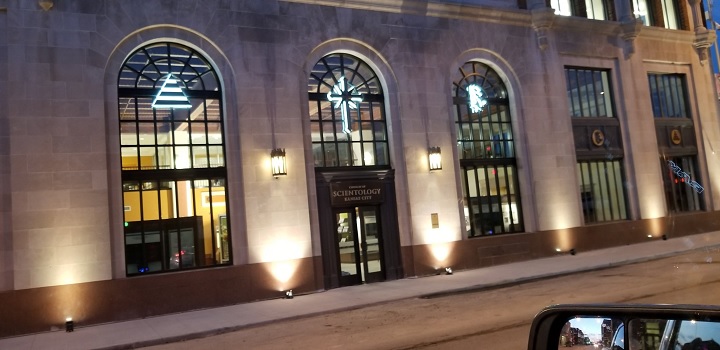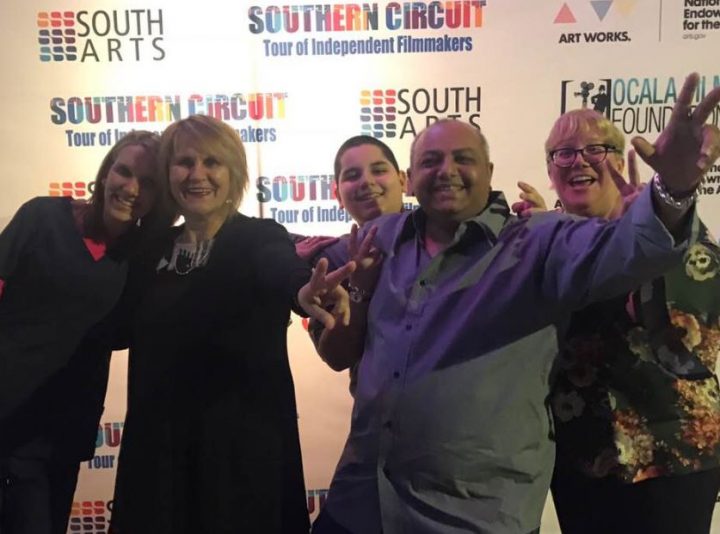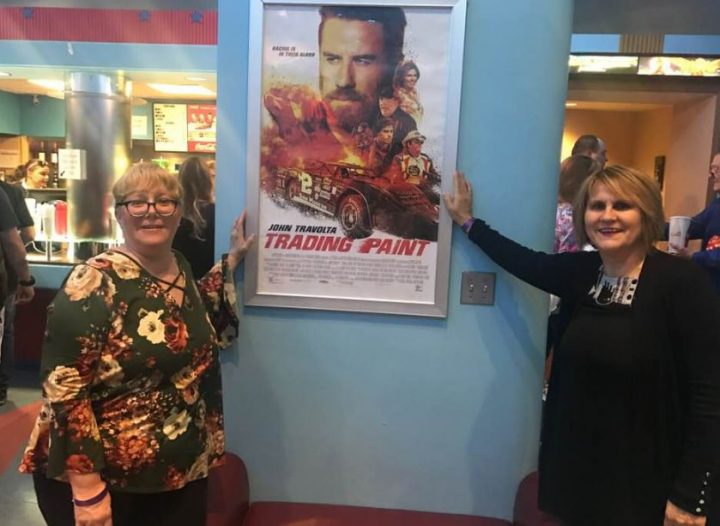
This week on Scientology Lit, we have an excerpt from Shrapnel in the San Fernando Valley, a memoir by Los Angeles contemporary artist Carol Es which will be coming out on April 6. The book wrestles with Carol’s experiences growing up in a dysfunctional family in LA’s San Fernando Valley, abuse by men who objectified her, and her struggles and success as a rock drummer and artist. The book also has some illuminating anecdotes from her life in Scientology, and she graciously agreed to give us this excerpt from her experience working at a Narconon drug rehab.
[My Scientologist friends] seemed to have their shit together. Their families too. They seemed sane compared to my family, though anyone’s would. The desire to better oneself began to rub off on me, and there was no doubt I needed and wanted control over my life. Haunted by death and failed relationships, losing my brother to drug addiction, a job with no true future, I started gravitating back to the idea of officially practicing Scientology. Maybe it would help.
The transition began with [my friend] Tanya becoming my FSM (Field Staff Member). These are Scientologists who try to get new or fallen people into the Church and onto their next service. They are akin to sponsors, only they get a 10 percent commission on everything you do in Scientology for the rest of your days. I do not believe Tanya’s purpose was financially motivated, but what do I know? She seemed to care. She came over after work nearly every day, and we used Scientology books and techniques. We mostly used the Ethics Book. Of all of them, it has the most tangible and applicable exercises. Working with her, I climbed out of a dark place and gained some self-respect. I saw that being an enemy to myself wasn’t getting me anywhere. The information in this book actually helped me, and it would later become my go-to book for solving just about every problem I had.
During the first couple of months we hung out, Tanya also brought with her the Scientology community newspaper, Needs and Wants. It mostly listed classifieds, and she encouraged me to find a better job. In fact, she sort of pointed out that I might have been contributing to the country’s drug consumption problem by working at a pharmacy, which distributes sinful psychiatric drugs. This set off alarms in my mind. Not because it sounded like her views were kooky, but because I believed that psychiatric drugs were bad. By then, I blamed psychiatry and the pharmaceutical companies for ruining my mother and taking her from my childhood. I also blamed them for the underlying cause of [my brother] Mike’s drug problems, since he’d been given Ritalin as a child. I’d read in one of the Scientology magazines (Advance!, Celebrity, Freewinds, Impact, etc.) that drug addiction and having been prescribed Ritalin were related. I blamed any and all of these medications for most of the world’s evils.
Hubbard felt that people with “psych” histories were ruined beyond repair. While you train to be an auditor, you view scores of technical films, most of which are propaganda about how dangerous psychiatry is: 1950s-style reenactments of crazy, high-voltage, electroshock treatments performed on patients screaming for their lives. Time and time again I saw people over-drugged and drooling in dirty gutters, lobotomies performed with ice picks, and illustrations of inhuman practices used in the beginnings of psychiatry by uneducated “doctors” who didn’t know what they were doing. This would scare the shit out of anyone. These films make the whole psychiatric field look barbaric. According to Hubbard, and Scientologists worldwide, psychiatrists are wicked beings who have been trying to ruin thetans for trillions of years. Most of the Scientology community are terrified of psychiatry on a very visceral level. They’re portrayed with the power of darkness equal to that of the Devil himself. I was petrified of being in a room with even a social worker, because they train in the world of psychology, which is essentially the same thing. I didn’t want to be affiliated to it in any way and definitely didn’t want to contribute to it. In my mind, I had to quit my pharmacy job immediately.
As Tanya kept bringing me different issues of Needs and Wants, I saw an ad that stood out every time I came across it. Save people’s lives! Help them recover from drugs and alcohol. These words really appealed to me. I thought, If I can’t get my own brother off drugs, maybe I can get a hundred other people off them. I wanted to feel useful and have a purpose, as I’d always felt useless. After some thought, mixed with a dash of desperation, I called the Narconon Rehabilitation Center.
The particular Narconon Detox Center I worked in was considered its “celebrity” branch. In reality this meant the services provided were more expensive, and the place wasn’t a dump. The offices were located on Lankershim Boulevard, above a jewelry shop in Studio City, and relatively small.
Though Narconon is a Scientology-run drug rehabilitation center, it has purposely become more and more cryptic about its connection to Scientology. Accrediting the curriculum to L. Ron Hubbard is buried deep in the informational materials, and all the Scientology jargon has been taken out. Some people don’t know what they’re getting themselves into with Narconon. When I first worked there, we used Scientology bulletins, processing, and E-meters.
To my recollection, there were never more than twenty people on service at a time. During my job interview, I sat down with a very young, brown-haired, brown-eyed Austrian girl named Gertraude. She told me I would get trained for free while I answered phones. Eventually, I’d be able to detox people. It was a full-time commitment, though: a two-and-a-half-year contract and the pay was complicated. Depending on a person’s training level, they received a certain number of credits, which were divided among the staff. Payment was related to how many new clients came in per week, or how much money came in the door. Gertraude said I could make anywhere from $100 to $750 per week, but she never mentioned that the pay could be zero, since no new sign-ups meant no one got paid. She also neglected to mention that paying the staff was the last item on the org’s to- do list—after rent, debts, phones, lights, and so on. This is L. Ron Hubbard’s “Management Tech.” I didn’t understand this until after I signed the contract. Truthfully, after my first interview, I could’ve sworn I wouldn’t be taking the job. However, Gertraude phoned me every day and put the pressure on. She insisted that she never had a paycheck less than $350, even in her most miserable week. She got me to believe I would be paid at least that, even though she made more credits. Basically, she lied.
I went back to see Gertraude for a second interview and met the rest of the staff. All of them were very nice, except one. I met Gunter when I had to do some tests, like the infamous Personality Test. I also took an IQ and an aptitude test. I wanted to know my IQ anyway and gladly agreed to do this. Once I got to the course room, Gunter was already there.
Gunter was seventeen years old, from Germany, and worked there full-time while he studied film at Los Angeles Community College. When I discovered he was three years younger than me and the Organization Executive Secretary (OES), it pretty much floored me. The OES runs the entire “technical” division for all the client services. For Narconon, this included drug withdraw and detox, all the courses, and the Purification Rundown (the sweat-out portion of the treatment). That’s everything — all the services Narconon offers. Gunter was in charge of all of that. Gunter had already reached OT IV. I hadn’t met too many OTs before, only [my friend,] Vicky’s parents. Still, any OT level impressed me back then. I thought it meant you had psychic powers or something.
Anyhow, Gunter was rather aloof. He sat silently at his desk in front of a completely empty course room while I did my tests, which took almost two hours. He graded them as I waited in my seat and the atmosphere gained weight all around me, my nerves like spiders escaping my shirt collar. When he finished grading the IQ test, he looked up at me and at last spoke with a thick German accent and a flat demeanor.
“Well, it looks like you have the IQ of a toad.”
His dry sense of humor bordered on arrogant, but I thought he was kind of cute and funny. Gunter stood six feet four inches, was skinny with long, dirty-blond hair and a chiseled face.
Unfortunately, he wore cowboy boots and dressed like a Guns n’ Roses fan, due to the fact that he was one. I hated this look. Then, when I asked if he and Gertraude were together, he laughed with a series of snorts and condescending eye rolls, exclaiming that in no way would he ever be her boyfriend. I was stupid to assume it on the basis of their similar accents. I pointed out that up till now, he’d insulted me twice: first by calling me a toad and then by saying that I was stupid. He clarified that he hadn’t called me a toad, only that I had the IQ of one.
One of the key reasons I decided to work at Narconon wasn’t just the pipe dream of helping my brother, or making up for not helping him. Gunter made a big impression. Intelligent, close to my age, and funny, I liked him. I also wanted his job. He had the most hands-on job that directly helped people. He’d soon be phasing out and going to school full-time. I couldn’t get over how someone so young could already be OT IV and have so much responsibility. It inspired me. But many kids raised in the Church had both the time and resources to do their Bridge.
“The Bridge” means processing through all of Scientology, otherwise known as “The Bridge to Total Freedom.” I suppose it’s called freedom because Hubbard believed that the physical universe we live in is, in fact, a trap. It’s the laws of the universe that keep us from being more than our bodies. Doing the Bridge is a way to free oneself from the body and operate as a spiritual being. This is what attracted me to Scientology, all the way through, 100 percent.
After I went through the testing, I continued to have reservations about working at Narconon: the pay versus commitment. The rest of the executive staff cornered me in one of the offices and coaxed me into signing the contract. The job would be important. Honorable. I’d be saving people’s lives! People like my brother. Gertraude, Gunter, and the rest of the staff made me believe I could potentially get my brother into the program. They promised to coach me. The pipe dream began to feel real. Any Scientology services they happened to deliver at that Narconon, would be available to me, free of charge.
Within a month, I put in ten-and-a-half-hour days, sometimes more, since I had to do training courses. Gunter would be leaving his post in less than a year, and I had to be fully trained to take over. My climb up the Scientology totem pole began. It’s not something you can rush. It’s difficult to explain to a non-Scientologist how Scientology works, what it really is, and what it does to you. I know I can speak for many of us who’ve left and tell you, this is nearly a futile task.

There are two systems of “tech” that Hubbard founded. One covers the spiritual processing (as well as the training to administer that processing) and consists of huge volumes of bulletins printed in red lettering on white, legal-size paper, often referred to as “red on white” or the “red volumes.” The other system is the Management Tech, “green on white,” similarly consisting of thousands of bulletins. Within these volumes, Hubbard lays out the “correct” way to run an organization, business, or group of any kind. You should know that Scientologist-owned corporations and businesses (or most of them) are run in this manner. Even when going up the ranks in Management, it’s often a prerequisite to have had some processing and/or courses in Scientology. Therefore, if you work for a Scientology-owned company that incorporates L. Ron Hubbard Management Tech, that’s what you’re in for.
Whether you are in the Narconon program as a student or “client,” as we called them, or you are training to work there, everyone must start with the Communication Course (or Comm Course), which is technically the first step on the Bridge. This is truly how all indoctrination of Scientology begins. Communication is broken down into the basics of what, how, and why it works and how to master it. Then you are put through a series of Training Routines (TRs). These are applicable drills for applying these concepts until you become notably skilled at the whole shebang. Once you’ve gained transcendent skills in the TRs, you’ll have the ability to put your TRs “in” at will. Very important.
In nearly every drill, you sit across from your “twin,” the person whom you’re partnered with for your course. Don’t worry, just because they are your twin, they don’t look anything like you. The chairs aren’t comfortable, but they’re not supposed to be. Not according to Hubbard. In the first drill, you sit in chairs placed three feet apart, facing each other with eyes closed. Feet are flat on the floor; hands are in your lap. It’s awkward. Try to relax. You are simply required to “be there” comfortably, without moving. It might seem Zen but it’s not. You can’t wiggle around, shake your legs, act nervous, or otherwise fidget or flinch. And you definitely can’t yawn. That’s a “Flunk! Start over!”
The next TR is similar, only your eyes are open. Same thing, you must be able to be there comfortably, and, trust me, it takes a long time—hours—before that happens. You’ll fall asleep, hallucinate, want to jump out of your skin and scream, but you will get to a place where you feel as though you could sit there all day if necessary. Until then, your face will itch and you’ll want to scratch, but you can’t. You’ll get irritable and desperately wish it would end. You won’t pass the drill until you have a particular epiphany. Since you are always expected to experience an “end phenomenon,” the one you’ll most likely reach is the one suggested in the material you read before the exercise begins.
Apparently, there’s been an ongoing, psychological debate about hypnosis. Experts and laymen continue to argue what it even means. Defined by dictionary.com as: An artificially induced trance state resembling sleep, characterized by heightened susceptibility to suggestion, the editors of the dictionary might be brighter than we think. I’m not an expert, but what I do know is that the TRs are insidious. They mesmerize, and they’re trance-inducing. Staring at another person in the eyes for a couple of hours without moving puts you in some kind of state, and coming out of it can easily be mistaken as a kind of “clarity.” Maybe even a mania. While you may feel it’s a heightened awareness, you’re really in a highly controllable state, susceptible to suggestion. Many people feel “good” after this step, and after Scientology processing too. This is referred to as experiencing a “win.”
I believe that when a person walks into a Scientology center of any kind to take the Personality Test, they are forfeiting some amount of their control. In that very moment, a treacherous process known as Illusion of Control by Proxy begins. It’s strange, but most people will give up their control if another person is thought to have more knowledge or skill than they do.
This, in turn, opens them up to far more suggestion than you’d ever think. One Training Routine that’s especially mind-numbing is called “bullbaiting.” Enough bullbaiting will suck you dry of your visceral human reactions. I know. I’ve done at least a thousand hours of bullbaiting, if not more.
In bullbaiting, you must sit (comfortably) without flinching one iota while your twin and/or others do everything in their power to make you laugh, piss you off, break you down, or somehow cause you to react. The only rule is they cannot touch you. Everything else is on the table. It gets as crazy as you might imagine. After many hours of this, your feelings, one by one, get stripped away.
Eventually, you’re able to use your TRs in any given situation, emotionally unaffected, just as you wish, and sometimes (more often than not) when you don’t wish. You’re programmed to think emotions are weak. For me, it was easier to keep my TRs in, like on autopilot, for self-preservation reasons.
I did more hours of bullbaiting than a typical Scientologist would ever endure. I soon became a course supervisor, and I’d have to sit in as the twin when there was only one student, which happened a lot. I became absolutely numb. Desensitized. It took years after I left Scientology to learn that having natural human reactions to disconcerting events was a good thing. These reactions are how we protect ourselves from danger. They utilize our critical thinking skills and help to develop healthy boundaries. But enough bullbaiting will chisel away at these highly needed primitive instincts. Maybe you’ll have the ability to cut through the bullshit and get your communication across when you want to, but you’ll also be seen as a real asshole to others.
Indoctrination doesn’t stop with the TRs, though I believe it’s a central part of the mind control, save the social peer pressures. There’s also a distinct way you read every word on the page as you study. There’s a thing called, “Study Tech.” You're expected to look up the definitions of the words in the text. “Word clearing” will make you feel as though you fully understand, with certainty, the concepts that you’re reading. This indisputable “certainty” is intended to show you how Hubbard makes perfect sense. What happens is, as some trust has already been established, you lose sight of the fact that this confirmation of certainty should be applied only to the words themselves, not the concepts. I never met anyone in Scientology who would agree that truth and certainty weren’t interchangeable. They think it’s the same thing. I came to believe this too.
The entire time I worked at Narconon, we were understaffed. For a business that’s supposed to run like a tight ship, I’d say we would’ve received a big fat “Flunk!” It seemed everyone flew by the seat of their pants. I wasn’t there three weeks before I had to do a detox watch. This takes place before the clients do the Comm Course, since they usually arrive wasted. They binge the night before entering rehab as a last hurrah.
Without any prior training, I was sent into the trenches on a forty-eight-hour detox watch and instructed never to let the client, Cynthia, out of my sight. I read a quickie training manual an hour before I met her. The girlfriend of a heavy metal rock star, her love of black leather and spikey stuff helped me to keep a distance. Not my style, and never my music scene. But I was only concerned with helping her overcome her addiction to shooting up cocaine. Due to her relationship to this high-profile guy, the Executive Director of our Narconon, Clark, agreed to an unorthodox arrangement: the detox would take place at her fancy condo in Glendale. Clients undergoing the program were usually supervised together under the same roof. Though it had its charm, the place we used was a dilapidated building in Hollywood called the Ardmore. These single apartments were located near Normandie and Melrose in a neighborhood ironically notorious for scoring drugs.
Cynthia, too swank to stay in such a place, insisted we come to her. Once I got there, I had to go through her two-bedroom condo and look for any drug-related paraphernalia. It took hours. While she slept upstairs, I went through her personal life and searched in every conceivable hiding place, including the backs of drawers, underneath and inside the toilet tanks, even inside shampoo bottles. I looked everywhere. I couldn’t find so much as a granule of coke, but somehow she was high. At one point, when I was in the bathroom, someone came to her door to drop off a duffel bag of her gym clothes. Gah! I checked the bag and found nothing. I couldn’t figure out where she hid the stuff, but she stayed up cleaning her kitchen all night. I called Clark. He said there was nothing I could do other than continue to watch her.
The second night, I figured she must have been out of drugs. She slept soundly. I’d been awake the whole time—without cocaine. I finally fell asleep next to her on the bed. In the early morning hours, I awoke to blood spraying onto my face. She shot up right next to me and slightly missed her vein. Later, I found out that she was HIV positive.
Welcome to working at Narconon. No biggie.
Every day after work, I put in three hours of course time at the Advanced Org (AOLA) from 7:00 to 10:00 p.m. After that, I’d drive back to Studio City and pick up the client folders at the office and drive them up to Burbank hills to the Case Supervisor’s house and leave them on his porch. He assessed everyone’s case. No one could move forward without the blessed, handwritten notes from the Case Supervisor. After driving back home to Van Nuys from Burbank, I’d have to pick those folders up in the morning and be at work by 10:00 a.m. Every cent for gasoline to drive all-over-the-fuck came out of my pocket. My credit card bills went through the roof trying to survive a job. All for the good of the world. To “save lives!” But I was never trying to save my own.
— Carol Es
——————–
Your proprietor on WGN
Last year, while we were in Chicago for HowdyCon, we made a visit to the WGN studios where Larry Potash was putting together a series on controversial groups, including Scientology. His interview of us finally aired and popped up on YouTube, and we thought we’d share it here. Mostly, it brought back great memories of our time in the Windy City. Thank you again, Chee Chalker, for such a wonderful meetup!
——————–
Is Kansas City ready for its close-up?
A reader sent us this image a couple of days ago, showing that the window coverings are off and the Kansas City Ideal Org looks very close to ready for its grand opening…

Can anyone tell us if a big ribbon is on the building yet? Is David Miscavige visiting the heartland today, or is the opening a few weeks off yet?
——————–
Bonus items from our tipsters
According to the captions on these photos, “VIP” seats were saved for people from the local Ocala Scientology mission in Florida for the world premiere of a new John Travolta movie, Trading Paint.


About the movie, the NY Post says, “There’s potential for pleasure in an old story done right, but Travolta croaking out a Southern accent as he overplays his outbursts and emotional reconciliations doesn’t qualify.”
——————–
HowdyCon 2019 in Los Angeles
This year’s HowdyCon is in Los Angeles. People tend to come in starting on Thursday, and that evening we will have a casual get-together at a watering hole. We have something in mind, but for now we’re not giving out information about it.
Friday night we will be having an event in a theater (like we did on Saturday night last year in Chicago). There will not be a charge to attend this event, but if you want to attend, you need to RSVP with your proprietor at tonyo94 AT gmail.
On Saturday, we are joining forces with Janis Gillham Grady, who is having a reunion in honor of the late Bill Franks. Originally, we thought this event might take place in Riverside, but instead it’s in the Los Angeles area. If you wish to attend the reunion, you will need to RSVP with Janis (janisgrady AT gmail), and there will be a small contribution she’s asking for in order to help cover her costs.
HOTEL: Janis tells us she’s worked out a deal with Hampton Inn and Suites, at 7501 North Glenoaks Blvd, Burbank, (818) 768-1106. We have a $159 nightly rate for June 19 to 22.

——————–
Scientology’s celebrities, ‘Ideal Orgs,’ and more!
We’ve been building landing pages about David Miscavige’s favorite playthings, including celebrities and ‘Ideal Orgs,’ and we’re hoping you’ll join in and help us gather as much information as we can about them. Head on over and help us with links and photos and comments.
Scientology’s celebrities, from A to Z! Find your favorite Hubbardite celeb at this index page — or suggest someone to add to the list!
Scientology’s ‘Ideal Orgs,’ from one end of the planet to the other! Help us build up pages about each these worldwide locations!
Scientology’s sneaky front groups, spreading the good news about L. Ron Hubbard while pretending to benefit society!
Scientology Lit: Books reviewed or excerpted in our weekly series. How many have you read?
——————–
THE WHOLE TRACK
[ONE year ago] Stop interacting with Scientology’s Internet trolls. Here’s proof it can backfire on you badly.
[TWO years ago] State investigators fired for blowing the whistle on Scientology’s rehabs get hearing in Denver
[THREE years ago] Scientology attorney Bert Deixler takes another swing at Karen de la Carriere
[FOUR years ago] ‘Going Clear’: Mike Rinder helps us understand a Scientology document that will creep you out
[FIVE years ago] Three weeks out of Scientology: Fresh information from a ‘blown’ Sea Org member
[SIX years ago] Blood Brother Ron: Starting Out Life on the Wrong Blackfoot
[SEVEN years ago] Scientology on the High Seas: Posing as Archaeology Students for the Sardinians
——————–
Bernie Headley has not seen his daughter Stephanie in 5,395 days.
Valerie Haney has not seen her mother Lynne in 1,524 days.
Katrina Reyes has not seen her mother Yelena in 2,028 days
Sylvia Wagner DeWall has not seen her brother Randy in 1,508 days.
Brian Sheen has not seen his grandson Leo in 571 days.
Geoff Levin has not seen his son Collin and daughter Savannah in 459 days.
Christie Collbran has not seen her mother Liz King in 3,766 days.
Clarissa Adams has not seen her parents Walter and Irmin Huber in 1,634 days.
Carol Nyburg has not seen her daughter Nancy in 2,408 days.
Jamie Sorrentini Lugli has not seen her father Irving in 3,182 days.
Quailynn McDaniel has not seen her brother Sean in 2,528 days.
Dylan Gill has not seen his father Russell in 11,094 days.
Melissa Paris has not seen her father Jean-Francois in 7,014 days.
Valeska Paris has not seen her brother Raphael in 3,181 days.
Mirriam Francis has not seen her brother Ben in 2,762 days.
Claudio and Renata Lugli have not seen their son Flavio in 3,022 days.
Sara Goldberg has not seen her daughter Ashley in 2,062 days.
Lori Hodgson has not seen her son Jeremy and daughter Jessica in 1,774 days.
Marie Bilheimer has not seen her mother June in 1,300 days.
Joe Reaiche has not seen his daughter Alanna Masterson in 5,389 days
Derek Bloch has not seen his father Darren in 2,529 days.
Cindy Plahuta has not seen her daughter Kara in 2,849 days.
Roger Weller has not seen his daughter Alyssa in 7,705 days.
Claire Headley has not seen her mother Gen in 2,824 days.
Ramana Dienes-Browning has not seen her mother Jancis in 1,180 days.
Mike Rinder has not seen his son Benjamin and daughter Taryn in 5,482 days.
Brian Sheen has not seen his daughter Spring in 1,588 days.
Skip Young has not seen his daughters Megan and Alexis in 1,990 days.
Mary Kahn has not seen her son Sammy in 1,862 days.
Lois Reisdorf has not seen her son Craig in 1,445 days.
Phil and Willie Jones have not seen their son Mike and daughter Emily in 1,940 days.
Mary Jane Sterne has not seen her daughter Samantha in 2,194 days.
Kate Bornstein has not seen her daughter Jessica in 13,303 days.
——————–
 Posted by Tony Ortega on March 23, 2019 at 07:00
Posted by Tony Ortega on March 23, 2019 at 07:00
E-mail tips to tonyo94 AT gmail DOT com or follow us on Twitter. We also post updates at our Facebook author page. After every new story we send out an alert to our e-mail list and our FB page.
Our new book with Paulette Cooper, Battlefield Scientology: Exposing L. Ron Hubbard’s dangerous ‘religion’ is now on sale at Amazon in paperback and Kindle formats. Our book about Paulette, The Unbreakable Miss Lovely: How the Church of Scientology tried to destroy Paulette Cooper, is on sale at Amazon in paperback, Kindle, and audiobook versions. We’ve posted photographs of Paulette and scenes from her life at a separate location. Reader Sookie put together a complete index. More information can also be found at the book’s dedicated page.
The Best of the Underground Bunker, 1995-2018 Just starting out here? We’ve picked out the most important stories we’ve covered here at the Underground Bunker (2012-2018), The Village Voice (2008-2012), New Times Los Angeles (1999-2002) and the Phoenix New Times (1995-1999)
Other links: BLOGGING DIANETICS: Reading Scientology’s founding text cover to cover | UP THE BRIDGE: Claire Headley and Bruce Hines train us as Scientologists | GETTING OUR ETHICS IN: Jefferson Hawkins explains Scientology’s system of justice | SCIENTOLOGY MYTHBUSTING: Historian Jon Atack discusses key Scientology concepts | Shelly Miscavige, ten years gone | The Lisa McPherson story told in real time | The Cathriona White stories | The Leah Remini ‘Knowledge Reports’ | Hear audio of a Scientology excommunication | Scientology’s little day care of horrors | Whatever happened to Steve Fishman? | Felony charges for Scientology’s drug rehab scam | Why Scientology digs bomb-proof vaults in the desert | PZ Myers reads L. Ron Hubbard’s “A History of Man” | Scientology’s Master Spies | The mystery of the richest Scientologist and his wayward sons | Scientology’s shocking mistreatment of the mentally ill | The Underground Bunker’s Official Theme Song | The Underground Bunker FAQ
Watch our short videos that explain Scientology’s controversies in three minutes or less…
Check your whale level at our dedicated page for status updates, or join us at the Underground Bunker’s Facebook discussion group for more frivolity.

Our non-Scientology stories: Robert Burnham Jr., the man who inscribed the universe | Notorious alt-right inspiration Kevin MacDonald and his theories about Jewish DNA | The selling of the “Phoenix Lights” | Astronomer Harlow Shapley‘s FBI file | Sex, spies, and local TV news | Battling Babe-Hounds: Ross Jeffries v. R. Don Steele








